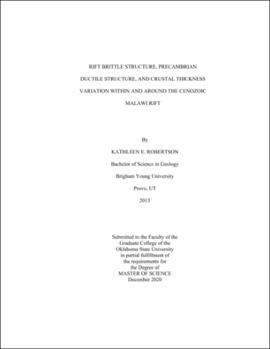| dc.contributor.advisor | Abdelsalem, Mohamed | |
| dc.contributor.author | Robertson, Kathleen E. | |
| dc.date.accessioned | 2021-05-25T20:42:27Z | |
| dc.date.available | 2021-05-25T20:42:27Z | |
| dc.date.issued | 2020-12 | |
| dc.identifier.uri | https://hdl.handle.net/11244/329976 | |
| dc.description.abstract | This study examines the relationship between the regional brittle structure associated with the Cenozoic southern Malawi Rift and the surrounding ductile structure of the Precambrian crystalline basement, as well as the controls of the Precambrian ductile structure and crustal thickness variation on rift brittle structure. | |
| dc.description.abstract | The southern Malawi Rift is characterized by a sharp change in orientation from NNW-trending in the north to NE-trending to the south before terminating against the Paleozoic - Mesozoic Shire Graben. Shuttle Radar Topography Mission (SRTM) Digital Elevation Models (DEM) and RADARSAT are used to map the rift brittle structure whereas aeromagnetic images are used to map Precambrian ductile structure. Variation in crustal thickness are obtained from previously published study that used two-dimensional radially-averaged power spectral analysis of the World Gravity Model 2012 (WGM 2012) to map the Moho depth beneath the southern Malawi Rift and its surroundings. After manually extracting the fault orientations for both the surface and basement structures, the data were divided using geophysical trends in the basement complex to create six structural domains. Each domain was applied over the same geographic area to examine structural inheritance within rift structures using rose diagrams for frequency analysis. | |
| dc.description.abstract | Within the study area, the brittle rift structures do not always correspond with the fabric of the basement complex and, in some cases, show only a minor relationship. The surficial structures react to pre-existing weaknesses in three ways: 1) follow the dominate trend of basement anisotropies; 2) cut across all basement anisotropies; or 3) have at least one trend that follows basement anisotropies and one or more trends that do not follow basement structures. | |
| dc.description.abstract | Crustal thickness data were also analyzed to examine the influence of crustal thickness heterogeneity on current rift structure. In the study area, crustal thickness seems to be a primary control for rift location and propagation and may correspond to the Niassa Craton underlying parts of the Southern Irumide Belt west of the study area. However, if the pre existing structures are favorably oriented, and severe crustal heterogeneity is absent, the rift will follow established basement structures. | |
| dc.format | application/pdf | |
| dc.language | en_US | |
| dc.rights | Copyright is held by the author who has granted the Oklahoma State University Library the non-exclusive right to share this material in its institutional repository. Contact Digital Library Services at lib-dls@okstate.edu or 405-744-9161 for the permission policy on the use, reproduction or distribution of this material. | |
| dc.title | Rift brittle structure, Precambrian ductile structure, and crustal thickness variation within and around the Cenozoic Malawi Rift | |
| dc.contributor.committeeMember | Atekwana, Estella | |
| dc.contributor.committeeMember | Lao Davila, Daniel | |
| osu.filename | Robertson_okstate_0664M_16981.pdf | |
| osu.accesstype | Open Access | |
| dc.type.genre | Thesis | |
| dc.type.material | Text | |
| dc.subject.keywords | east african rift | |
| dc.subject.keywords | malawi rift | |
| dc.subject.keywords | structural geology | |
| dc.subject.keywords | tectonics | |
| thesis.degree.discipline | Geology | |
| thesis.degree.grantor | Oklahoma State University | |
